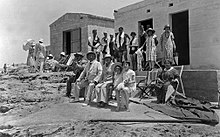Villa St Ignatius
It was built in the early 19th century for the English merchant John Watson, and it might be the earliest example of Gothic Revival architecture in the country.
Part of the building was controversially demolished in December 2017, violating a court order and attracting widespread condemnation by heritage NGOs and other entities.
Villa St Ignatius was built in the early 19th century for the English merchant, John Watson, and it was originally called Bel-Vedere.
[1] It was a landmark detached country villa overlooking Balluta Bay, and it incorporated a walled garden.
[6] Notable project at the college, from 1839 and 1845, was the Bible translation to Modern Standard Arabic which took place under the supervision of Lutheran missionary Samuel Gobat (1799–1879).
[7][8] Students from Europe and the Middle-East, such as Egyptians, Greeks and Turks, were hailed to Malta requiring their conversion but the overall expectations was not considered successful.
[9] Conversion to Protestant Christianity was controversial from such conservative countries; such was the case of a former Muslim family who after adopting the new faith found refuge in Malta and hosted at the college where they also received education.
[5] On 26 March 1872 the trustees sold the property to Dr Pasquale Mifsud (1833–1895), later a judge, and Carlo Maria Muscat, merchant and member of the Council of Government, for the sum of £2,200.
[16] A refectory, dormitories, a gymnasium, study halls, laboratories and sports facilities were located within the villa and on its grounds.
[30] It housed recovering soldiers who had been wounded in World War I, and it originally included 155 beds, an operating theatre and an X-ray room.
He and his team of architects and artists left a patrimony of watercolour paintings of Malta portraying how it used to be at the time.
[43] In July, the architect Stephan Vancell submitted a request to the Planning Authority to demolish an entire wing of the building, including the dangerous structures which were broken xorok (roof slabs) which could easily be replaced.
[55] On 11 April, the developer responsible for the partial demolition, Paul Gauci, applied to demolish the entire villa in order to create a public square.
[60] Villa St Ignatius was one of the earliest, and possibly the first, buildings in Malta to display the Gothic Revival style.
[44] By the early 20th century, the building was painted in a distinctive red ochre (Maltese: demm tal-baqra) with white trims.







